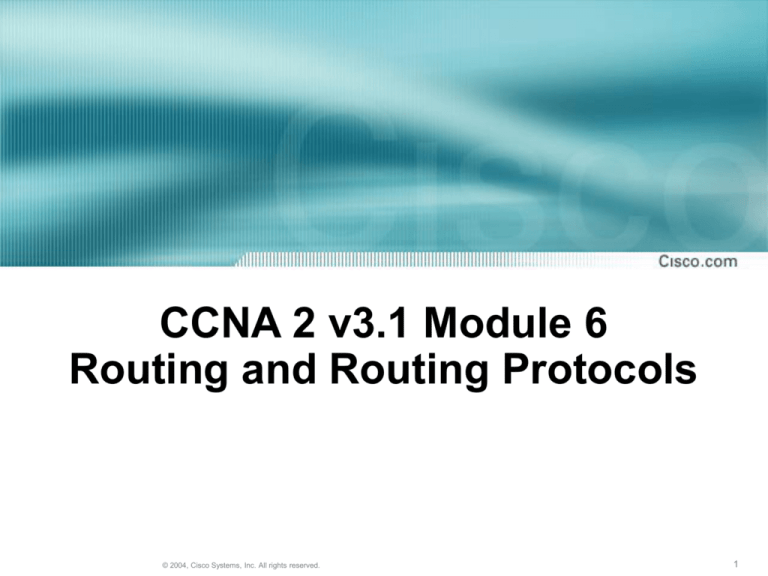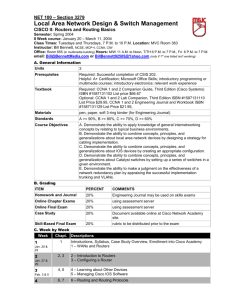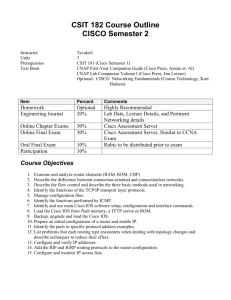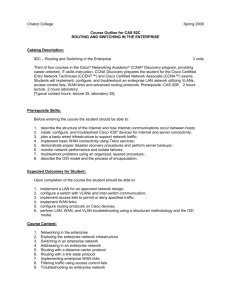
CCNA 2 v3.1 Module 6
Routing and Routing Protocols
© 2004, Cisco Systems, Inc. All rights reserved.
1
Purpose of This PowerPoint
• This PowerPoint primarily consists of the Target
Indicators (TIs) of this module in CCNA version
3.1.
• It was created to give instructors a PowerPoint to
take and modify as their own.
• This PowerPoint is:
NOT a study guide for the module final assessment.
NOT a study guide for the CCNA certification exam.
• Please report any mistakes you find in this
PowerPoint by using the Academy Connection
Help link.
© 2004, Cisco Systems, Inc. All rights reserved.
2
To Locate Instructional Resource
Materials on Academy Connection:
• Go to the Community FTP Center to locate
materials created by the instructor community
• Go to the Tools section
• Go to the Alpha Preview section
• Go to the Community link under Resources
• See the resources available on the Class home
page for classes you are offering
• Search http://www.cisco.com
• Contact your parent academy!
© 2004, Cisco Systems, Inc. All rights reserved.
3
Objectives
© 2004, Cisco Systems, Inc. All rights reserved.
4
Route Types
© 2004, Cisco Systems, Inc. All rights reserved.
5
Specifying Outgoing Interface
© 2004, Cisco Systems, Inc. All rights reserved.
6
Specifying the Next-hop IP Address
© 2004, Cisco Systems, Inc. All rights reserved.
7
Configuring Static Routes
© 2004, Cisco Systems, Inc. All rights reserved.
8
Non-directly Connected Networks
© 2004, Cisco Systems, Inc. All rights reserved.
9
Verifying Static Route Configuration
• The command show running-config is
used to view the active configuration in
RAM to verify that the static route was
entered correctly.
• The show ip route command is used to
make sure that the static route is present
in the routing table
© 2004, Cisco Systems, Inc. All rights reserved.
10
The show ip route Command Output
© 2004, Cisco Systems, Inc. All rights reserved.
11
Troubleshooting Static Route
Configuration
• The show interfaces command
• The ping command
• The traceroute command
© 2004, Cisco Systems, Inc. All rights reserved.
12
The ping and traceroute
Commands
© 2004, Cisco Systems, Inc. All rights reserved.
13
Routed Versus Routing Protocol
© 2004, Cisco Systems, Inc. All rights reserved.
14
Autonomous Systems
The American Registry of Internet Numbers (ARIN), a service
provider, or an administrator assigns a 16-bit identification number to
each AS. This autonomous system number is a 16 bit number.
Routing protocols, such as Cisco IGRP, require the assignment of a
unique, AS number.
© 2004, Cisco Systems, Inc. All rights reserved.
15
Dynamic Routing Operations
The routing protocol learns all available routes, places the best routes into the
routing table, and removes routes when they are no longer valid. The router uses
the information in the routing table to forward routed protocol packets.
© 2004, Cisco Systems, Inc. All rights reserved.
16
Dynamic Routing Operations
• The routing algorithm is fundamental to dynamic routing. Whenever the topology
of a network changes because of growth, reconfiguration, or failure, the network
knowledgebase must also change. The network knowledgebase needs to reflect
an accurate view of the new topology.
• Convergence Time
• Autonomous systems divide the global internetwork into smaller and more
manageable networks. Each AS has its own set of rules and policies and an AS
number that will distinguish it from all other autonomous systems.
© 2004, Cisco Systems, Inc. All rights reserved.
17
Classes of Routing Protocols
The distance vector
routing approach
determines the direction,
or vector, and distance to
any link in an
internetwork.
The link-state approach
recreates the exact
topology of an entire
internetwork.
© 2004, Cisco Systems, Inc. All rights reserved.
18
Distance Vector Concepts
An analogy of distance vector could be the signs found at a highway
intersection. A sign points toward a destination and indicates the distance to the
destination. Further down the highway, another sign points toward the
destination, but now the distance is shorter. As long as the distance is shorter,
the traffic is on the best path.
© 2004, Cisco Systems, Inc. All rights reserved.
19
Distance Vector Network Discovery
© 2004, Cisco Systems, Inc. All rights reserved.
20
Routing Metric Components
© 2004, Cisco Systems, Inc. All rights reserved.
21
Link-State Concepts
© 2004, Cisco Systems, Inc. All rights reserved.
22
Link-State Topology Changes
© 2004, Cisco Systems, Inc. All rights reserved.
23
Link-State Concerns
© 2004, Cisco Systems, Inc. All rights reserved.
24
Path Determination
A path determination function
A switching function
© 2004, Cisco Systems, Inc. All rights reserved.
25
Routing with Network Addressing
© 2004, Cisco Systems, Inc. All rights reserved.
26
IP Routing Configuration Tasks
© 2004, Cisco Systems, Inc. All rights reserved.
27
Using the router and network
Commands
© 2004, Cisco Systems, Inc. All rights reserved.
28
Routing Protocols
© 2004, Cisco Systems, Inc. All rights reserved.
29
Interior/Exterior Routing Protocols
© 2004, Cisco Systems, Inc. All rights reserved.
30
Summary
© 2004, Cisco Systems, Inc. All rights reserved.
31






